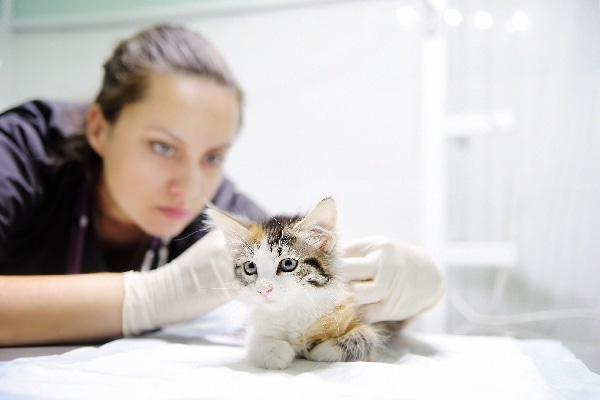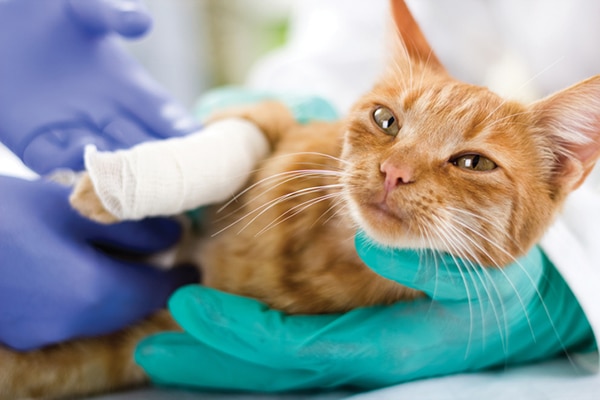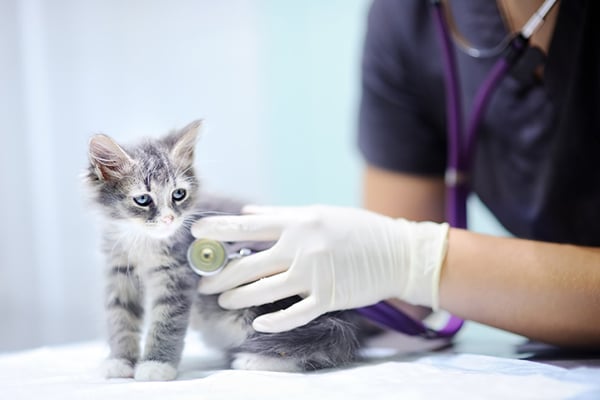As the cost of veterinary care continues to skyrocket year after year, many pet owners struggle to find affordable vet care for their cats. “With the incredible student loan debt, declining veterinary visits, and retailers taking more market share on basic preventative products, including pet food and even some pharmaceuticals, veterinary costs at best will maintain current levels, but are more likely to increase,” says Darren Taul, DVM, president-elect of the American Animal Hospital Association and owner of two veterinary hospitals in Central Kentucky.
So, what’s a cat owner to do about finding affordable vet care? First, staying on top of your cat’s health with routine care is the best way to ward off future health issues. Don’t skip seeing the vet for years and years even if your cat seems healthy. “The most important part of preventive care is annual veterinary visits (for pets less than 7 years of age) and semi-annual veterinary visits (for pets 7-plus years of age),” Dr. Taul advises. “So many things can be detected early and are much less costly than after a problem occurs.”
If paying for your cat’s veterinary expenses feels impossible, here are nine ways to find affordable vet care, including free and low-cost routine and emergency vet care assistance:
1. Low-Cost Spay/Neuter Services

Spaying or neutering your cat is not only the best way to reduce the pet overpopulation problem (which in turn keeps cats and kittens out of shelters), but your cat will be healthier in the long run. It’s expensive to care for unplanned litters of kittens, and the risk of certain health problems, including some types of cat cancers, can be greatly reduced or even avoided entirely simply by having your cat spayed or neutered. To find a free or low-cost spay/neuter program near you, contact local animal shelters, humane societies and rescue groups. These organizations will have the most up-to-date information on the resources available in your community.
2. TNR for Feral Cats
If you feed stray or feral cats in your yard or neighborhood, but can’t afford to do much more than that, many community TNR (trap-neuter-release) programs are available to help provide health care for these cats. “TNR programs are utilized mainly for feral cat colonies to control population while keeping cats in their own colonies,” Dr. Taul says. In addition to spaying or neutering the cats, many programs also provide vaccines and even parasite prevention. These groups will either trap the cats for you, or lend you traps and offer tips so you can trap the cats yourself. To find a program in your area, contact an animal shelter, humane society or cat-specific rescue group in your city or county.
3. Low-Cost Vaccine Clinics
Vaccines are an important part of keeping your cat healthy and free from disease. If you can’t afford the cost of routine vaccinations, contact your local shelter or humane society to ask about free or low-cost vaccine clinics in your community. Some pet-supply stores also host low-cost vaccine clinics.
4. Pet Savings Account

Anticipated costs like food and vaccines are hard enough to budget for, but the costs that really hurt are bills for serious or emergency treatment. Start a savings account and deposit a certain amount into it every month for each pet you own. Then, vow not to touch that money unless you need it to pay one of your pet’s vet bills.
5. Pet Insurance
Pet insurance helps you plan for the unexpected. It is mainly for illnesses and injuries, not for preventive care like vaccines and dental cleanings. “It is important to know that pet health insurance does not cover pre-existing problems,” Dr. Taul explains. “The best time to enroll in pet health insurance is while [your cat] is young and healthy. If you wait, you can still get coverage, but it won’t cover any previously diagnosed problems and is often more expensive.” Read more about pet insurance for cats here.
6. Wellness Plans
The opposite of pet insurance, wellness plans cover only preventive care, not illnesses and injuries. These types of plans might be offered directly from your veterinarian, or added on to most pet insurance policies for an additional fee.
“Well pet plans are nice and are very similar to a pet savings account by most standards,” Dr. Taul says.
7. Payment Plans
If your cat needs veterinary care and you can’t afford to pay a large sum up front, ask your veterinarian if they will allow you to pay your bill in smaller installments over time. Some clinics will set you up with a payment plan with no additional fees; others require a small processing fee and/or interest. Some third-party companies like ScratchPay offer payment plans that don’t require a credit check. Essentially loans, such plans charge interest, but allow you to pay over time.
8. Credit Cards for Vet Expenses
If you’re faced with a large vet bill and you’ve maxed out your credit cards, you might be able to get a special line of credit strictly for veterinary expenses. Third-party credit companies like CareCredit offer a variety of financing options for pet owners. “Third-party veterinary credit cards certainly serve a great purpose and fulfill the needs of pet owners who are not prepared for unexpected veterinary expenses,” Dr. Taul explains. “Many have low or no interest for a period of time, which is similar to a payment plan. This type of service can be a lifesaver, but people with no credit history or a bad credit score might have difficulty being approved.”
9. Financial Assistance Programs
If you have exhausted all other resources and need urgent medical treatment for your cat, a number of organizations offer assistance programs for pets whose owners cannot afford the cost of veterinary care. If you adopted your cat from a shelter or rescue group, first inquire with them to ask about any programs they might offer or know about for veterinary care of a rescued cat. If you hit a dead-end there, check out the following groups to see if you might be eligible for assistance:
- Brown Dog Foundation: Provides funding to families who find themselves with a sick pet that would likely respond to treatment, but due to unforeseen circumstances cannot afford the treatment.
- Cody’s Club: Offers financial assistance to help offset a portion of the cost of radiation treatments for pets.
- Dogs on Deployment: provides financial assistance to qualifying military members for help with pet care (dogs and cats) during times of need.
- Handicapped Pets Foundation: Provides wheelchairs and other equipment for dogs and cats with special needs.
- Kobi’s Fund: Provides financial assistance to owners who cannot afford treatment for their cats with vaccine-associated sarcoma.
- The Pet Fund: Financial assistance for pet owners who need help paying for veterinary care.
- RedRover: Provides financial assistance, resources and support to low-income individuals and survivors of domestic violence and their pets.
- Rose’s Fund: Offers financial assistance for veterinary bills for dogs and cats with a life-threatening illness, injury or condition.
- Shakespeare Animal Fund: Offers financial assistance for emergency veterinary care for pet owners on fixed incomes or with annual incomes below current poverty guidelines.
In addition to the above programs, Best Friends Animal Society maintains a listing of state-specific pet financial assistance programs on its website.
Thumbnail: Photography ©SbytovaMN | Thinkstock.
Tell us: What options for affordable vet care have you explored?
Read more about cat health on Catster.com:








